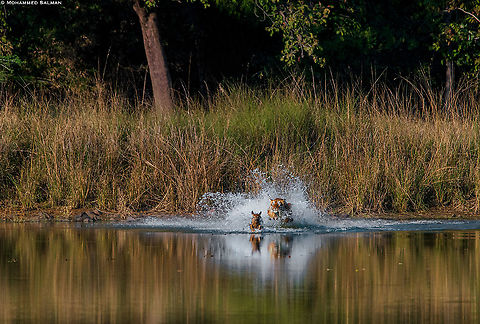
Appearance
The Bengal tiger's coat is yellow to light orange, with stripes ranging from dark brown to black; the belly and the interior parts of the limbs are white, and the tail is orange with black rings.Male Bengal tigers have an average total length of 270 to 310 cm including the tail, while females measure 240 to 265 cm on average. The tail is typically 85 to 110 cm long, and on average, tigers are 90 to 110 cm in height at the shoulders. The average weight of males is 221.2 kg, while that of females is 139.7 kg. The smallest recorded weights for Bengal tigers are from the Bangladesh Sundarbans, where adult females are 75–80 kg.
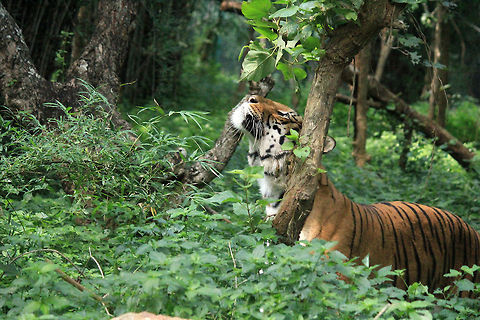
Distribution
In 1982, a sub-fossil right middle phalanx was found in a prehistoric midden near Kuruwita in Sri Lanka, which is dated to about 16,500 ybp and tentatively considered to be of a tiger.Tigers appear to have arrived in Sri Lanka during a pluvial period during which sea levels were depressed, evidently prior to the last glacial maximum about 20,000 years ago. In 1929, the British taxonomist Pocock assumed that tigers arrived in southern India too late to colonize Sri Lanka, which earlier had been connected to India by a land bridge.
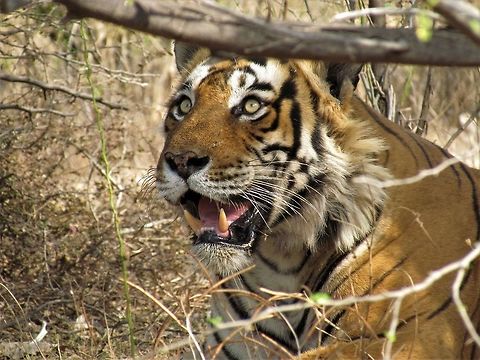
Status
WWF partnered with Leonardo DiCaprio to form a global campaign, Save Tigers Now, with the ambitious goal of building political, financial and public support to double the wild tiger population by 2022. "Save Tigers Now" started its campaign in 12 different WWF Tiger priority landscapes, since May 2010.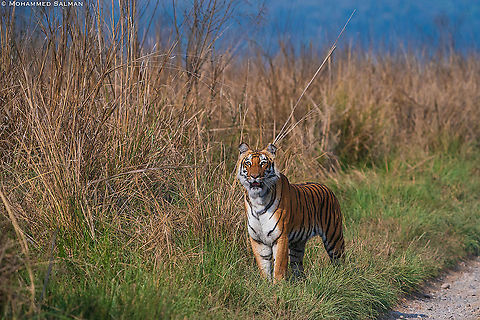
Behavior
The basic social unit of the tiger is the elemental one of mother and offspring. Adult animals congregate only on an "ad hoc" and transitory basis when special conditions permit, such as plentiful supply of food. Otherwise they lead solitary lives, hunting individually for the dispersed forest and tall grassland animals, upon which they prey.They establish and maintain home ranges. Resident adults of either sex tend to confine their movements to a definite area of habitat within which they satisfy their needs, and in the case of tigresses, those of their growing cubs. Besides providing the requirements of an adequate food supply, sufficient water and shelter, and a modicum of peace and seclusion, this location must make it possible for the resident to maintain contact with other tigers, especially those of the opposite sex. Those sharing the same ground are well aware of each other’s movements and activities.
The home ranges occupied by adult male residents tend to be mutually exclusive, even though one of these residents may tolerate a transient or sub-adult male at least for a time. A male tiger keeps a large territory in order to include the home ranges of several females within its bounds, so that he may maintain mating rights with them.
Spacing among females is less complete. Typically there is partial overlap with neighbouring female residents. They tend to have core areas, which are more exclusive, at least for most of the time. Home ranges of both males and females are not stable.
The shift or alteration of a home range by one animal is correlated with a shift of another. Shifts from less suitable habitat to better ones are made by animals that are already resident. New animals become residents only as vacancies occur when a former resident moves out or dies. There are more places for resident females than for resident males.
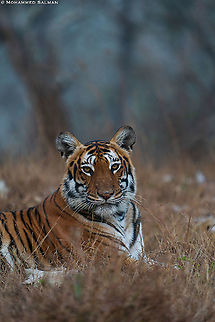
Habitat
In the Indian subcontinent, tigers inhabit tropical moist evergreen forests, tropical dry forests, tropical and subtropical moist deciduous forests, mangroves, subtropical and temperate upland forests, and alluvial grasslands.Latter tiger habitat once covered a huge swath of grassland and riverine and moist semi-deciduous forests along the major river system of the Gangetic and Brahmaputra plains, but has now been largely converted to agriculture or severely degraded.
Today, the best examples of this habitat type are limited to a few blocks at the base of the outer foothills of the Himalayas including the "Tiger Conservation Units" Rajaji-Corbett, Bardia-Banke, and the transboundary TCUs Chitwan-Parsa-Valmiki, Dudhwa-Kailali and Sukla Phanta-Kishanpur. Tiger densities in these blocks are high, in part a response to the extraordinary biomass of ungulate prey.
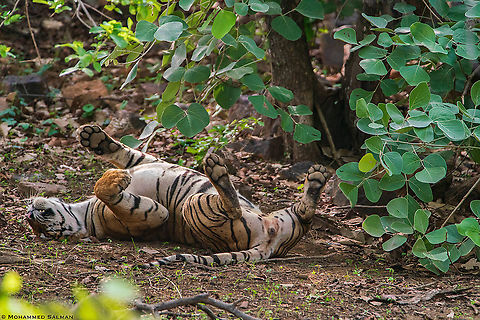
Reproduction
The tiger in India has no definite mating and birth seasons. Most young are born in December and April. Young have also been found in March, May, October and November. In the 1960s, certain aspects of tiger behaviour at Kanha National Park indicated that the peak of sexual activity was from November to about February, with some mating probably occurring throughout the year.Males reach maturity at 4–5 years of age, and females at 3–4 years. A tigress comes into heat at intervals of about 3–9 weeks, and is receptive for 3–6 days.
After a gestation period of 104–106 days, 1–4 cubs are born in a shelter situated in tall grass, thick bush or in caves. Newborn cubs weigh 780 to 1,600 g and they have a thick wooly fur that is shed after 3.5–5 months. Their eyes and ears are closed.
Their milk teeth start to erupt at about 2–3 weeks after birth, and are slowly replaced by permanent dentition from 8.5–9.5 weeks of age onwards. They suckle for 3–6 months, and begin to eat small amounts of solid food at about 2 months of age. At this time, they follow their mother on her hunting expeditions and begin to take part in hunting at 5–6 months of age.
At the age of 2–3 years, they slowly start to separate from the family group and become transient — looking out for an area, where they can establish their own territory. Young males move further away from their mother's territory than young females. Once the family group has split, the mother comes into heat again.
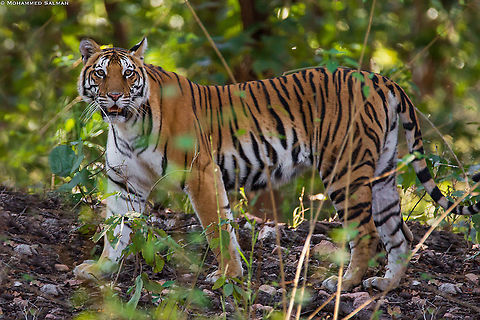
Food
Tigers are carnivores. They prefer hunting large ungulates such as chital, sambar, gaur, and to a lesser extent also barasingha, water buffalo, nilgai, serow and takin. Among the medium-sized prey species they frequently kill wild boar, and occasionally hog deer, muntjac and Gray langur.Small prey species such as porcupines, hares and peafowl form a very small part in their diet. Due to the encroachment of humans into their habitat, they also prey on domestic livestock.
In most cases, tigers approach their victim from the side or behind from as close a distance as possible and grasp the prey's throat to kill it. Then they drag the carcass into cover, occasionally over several hundred meters, to consume it. The nature of the tiger's hunting method and prey availability results in a "feast or famine" feeding style: they often consume 18–40 kilograms of meat at one time.
Bengal tigers have been known to take other predators, such as leopards, wolves, jackals, foxes, crocodiles, Asiatic black bears, sloth bears, and dholes as prey, although these predators are not typically a part of their diet.
Adult elephants and rhinoceroses are too large to be successfully tackled by tigers, but such extraordinarily rare events have been recorded. The Indian hunter and naturalist Jim Corbett described an incident in which two tigers fought and killed a large bull elephant. If injured, old or weak, or their normal prey is becoming scarce, they may even attack humans and become man-eaters.
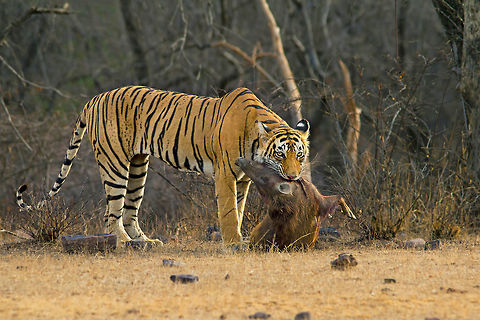
Cultural
The tiger is one of the animals displayed on the Pashupati seal of the Indus Valley Civilisation. The tiger crest is the emblem on the Chola coins. The seals of several Chola copper coins show the tiger, the Pandya emblem fish and the Chera emblem bow, indicating that the Cholas had achieved political supremacy over the latter two dynasties. Gold coins found in Kavilayadavalli in the Nellore district of Andra Pradesh have motifs of the tiger, bow and some indistinct marks.Today, the tiger is the national animal of India. Bangladeshi banknotes feature a tiger. The political party Muslim League of Pakistan uses the tiger as its election symbol.
⤷ A tiger features on the logo of the Reserve Bank of India.
⤷ The Kolkata team in the Indian Cricket League is called the Royal Bengal Tigers.
⤷ The Bangladesh Cricket Board's logo features a Royal Bengal Tiger.
⤷ The team representing Tollywood in Celebrity Cricket League is named Bengal Tigers.
⤷ Members of the East Bengal Regiment of the Bangladesh Army are nicked 'Bengal Tigers'; the regiment's logo is a tiger face.
⤷ The 2007 film "Maneater", based on Jack Warner's novel "Shikar", details the killing spree of an escaped Bengal tiger after it gets loose in a small town along the Appalachian Trail.
⤷ In the fantasy adventure novel "Life of Pi" and in the 2012 film a Bengal tiger is the lead character.
⤷ University of Missouri has Bengal Tiger as their mascot, students are known as tigers, their athletic team is Missouri Tigers, their web space and email as Bengal-space and Bengal-mail.
⤷ Louisiana State University's Tigers are nicknamed the Bayou Bengals.
⤷ Cincinnati's National Football League team is named the Cincinnati Bengals.
⤷ The varsity athletic teams representing Idaho State University in Pocatello, Idaho in intercollegiate athletics is named Idaho State Bengals.
⤷ The Detroit's MLB team Detroit Tigers are nicknamed the Bengals.
⤷ Dominican Republic's most successful baseball team Licey Tigers are nicknamed the Bengals.
⤷ German heavy tank Tiger II was informally known as "Königstiger"
⤷ The main antagonist of The Jungle Book, Shere Khan, is a Bengal tiger
References:
Some text fragments are auto parsed from Wikipedia.